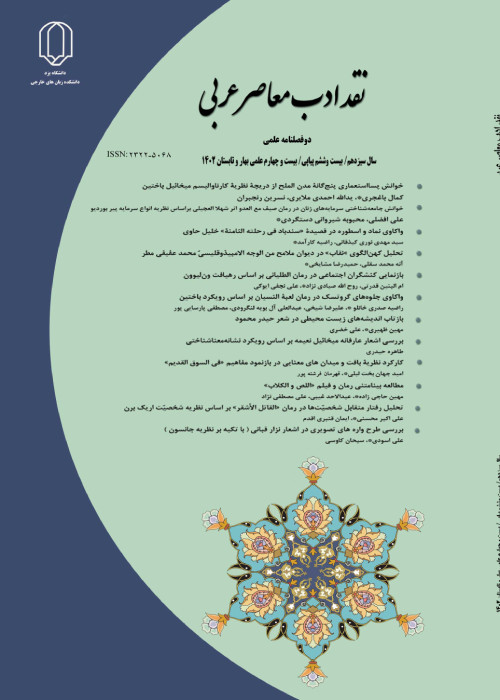An archetypical analysis of the patterns in Linda Nasser's poetry based on Jung's psychological theory: A case study of mask and shadow
After breaking away from Freud's school, Karl Gustav Jung developed the collective unconsciousness theory and set five patterns for the human personality psyche including the Self, the Shadow, the Persona, the Animus, and the Anima. In psychoanalysis, these five factors are used extensively. Archeological criticism seeks to examine the collective subconscious that Jung considers persona and shadow to be the most important and fundamental factors in the evolution of human personality. Jung believes that these archetypes are a common feature of all mankind and can be found in poetry. Considering the compatibility of the masks and shadows archives in the poetry of Linda Nasser, the present study makes attempts to explore her poetry in a descriptive-analytical way and to identify and explain the nature, personas, shadows and their use in her poetry. Linda Nasser, a Lebanese poet, in the Laenni Fi Uzlat (which means because I'm in isolation) collection, shows her poetic man with a persona. This persona is sometimes a mythical and sometimes a social character drawing on his ideas with a sense of identity. Moreover, in the human subconscious desired by Linda, there are shadows that one tries to keep hidden. The research findings suggest that Linda chooses behaviors such as evil, badness, sin, greed, and theft as shadows, and good traits such as stoicism, faith, mercy, and kindness as the traits of the human character in the community. These traits are carefully considered in the literature and are adaptable to Jung's theories.
The conservative Arab society in general and the Lebanese society in particular and the cultural and social practices in these societies create a gap between the text and the society, and the author tries to hide behind the text. Linda Nasar is a poetess who uses archetypes to describe herself. She shows herself, chooses the shadow and the mask so that she can continue her life from these archetypes. She also shows the meanings of the words to their readers by applying masks and shadows. Considering this study, the study of "Lani in solitude" and the critique of Carl Jung's archetype, it can be concluded that Linda Nassar also used archetypes such as fear of society's misconceptions, evil on the part of people in society, sinful deeds and public opinion about it, good and evil, and categories that introduce these two. Each of these archetypes indicates a particular behavior and can be subdivided into shadows and masks. This research seeks to show the shadow and mask in Linda Nasar's poetry a using descriptive-analytical method.
Archetypes that indicate disgusting behavior which every person seeks to hide are a subset of shadow, while appropriate social behaviors are a subset of mask. Linda Nassar's man has the same archetypes, shadows and masks. There are many reasons for her using archetypes, the most important of which is the conservative Lebanese society and the lack of physical and mental freedom of women in such a society. Linda refers to the bad temperament of human beings who are in the shadows, and everyone is aware of its existence and tries to hide it. The other person Linda talks about is full of evil and negative shadows. She describes the existence of such shadows as evil, hatred, resentment and sin. Linda Nassar resorts to shadows and masks to avoid the criticism of the society and its people, and she embodies two worlds in one direction, a world that adapts to reality and a world is what others want.
The poetess shows her hopes and aspirations for the shadow and induces her fear to the reader for successive masks. In this study, an attempt was made to examine the reasons for the use of masks and shadows in Linda Nassar's poetry according to Carl Jung's theory. It was found that the poet used many archetypes to fill the void caused by fear. The poetess is capable of conveying issues in an artistic and literary way. In societies where women's minds and bodies are involved in conservative and reactionary thoughts, it is necessary to speak in secret. The work of the eminent Lebanese poetess Linda Nassar conveys her thoughts by choosing the codes of mask and shadow and presenting a psychoanalytic writing to her reader.
- حق عضویت دریافتی صرف حمایت از نشریات عضو و نگهداری، تکمیل و توسعه مگیران میشود.
- پرداخت حق اشتراک و دانلود مقالات اجازه بازنشر آن در سایر رسانههای چاپی و دیجیتال را به کاربر نمیدهد.



